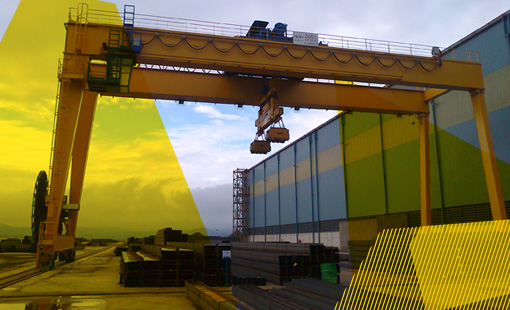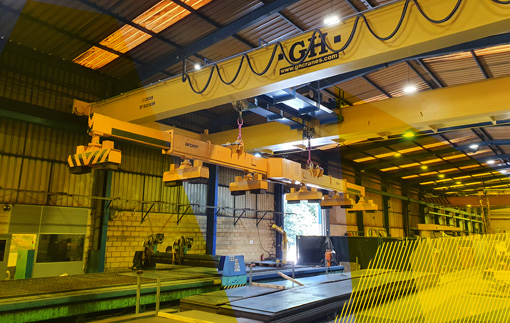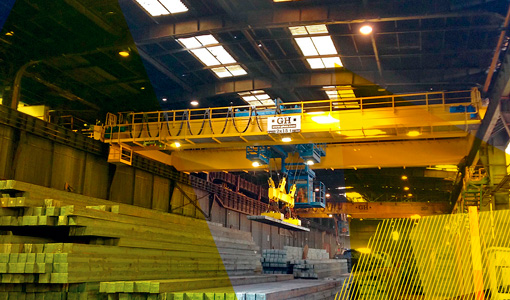If you are looking to buy and install an overhead crane for steel handling, you face a number of unique challenges. After all, steel making and steel warehousing present unique operational challenges around weight and temperature. Not all overhead cranes are up to the task.
When choosing an overhead crane for steel handling, you must consider safety, reliability and efficiency. Here are the top questions you must ask so that you choose the crane that is right for you.
Q1: How much weight do you need to lift?

Your first consideration is the capacity of your crane. Regardless of whether you are lifting steel coils, structural tubing, steel plates or something else, you need a crane that will handle the weight of your loads.
Overhead cranes are designed and engineered to lift weights that range from 500 kg to as much as 400 tons. Your goal is to select the crane that best matches your needs of today and your anticipated needs of tomorrow. You don’t want to buy less crane than you need—or more crane than you need.
Q2: What classification of crane do you need?
All overhead cranes are classified according to loads and cycles. The classification governs the intensity of the loads and the number of cycles the crane completes during a given period of time.
In the United States, there are six classifications:
- Class A – Infrequent or Standby. Ideal for precise handling at slow speeds.
- Class B – Light Service. Two to five lifts per hour.
- Class C – Moderate Service. Perform 5 to 10 lifts per hour. Loads average 50% of the rated capacity.
- Class D – Heavy Service. Perform 10 to 20 lifts per hour. Not more than 65% of the lifts at the crane’s rated capacity.
- Class E – Severe Service. Perform 20 of more lifts per hour at or near the rated capacity.
- Class F – Continuous Severe Service. Handle loads approaching the crane’s rated capacity and do so continuously, under severe service conditions (high temperatures, dusty environments).
Q3: What lifting, and travel speeds do you need?
- The ability to meet logistical requirements is dependent to cranes matching demand.
- High speeds are desirable in warehousing operations and on long runway systems.
- Precise speeds are needed for spotting loads and safe operation.
- GH offers as a standard ACVFD controls for all motions giving you both high speeds and precise spotting when needed.

Q4: Do you have the correct hook attachments?
Overhead cranes are a combination of crane structure and lifting mechanism (hoist).
- Top running single-girder overhead cranes. Give you optimal use of your available space while minimizing weight.
- Top running double-girder overhead cranes. Deliver greater stability when handling large loads.
- Underhung overhead cranes. Move loads over large spans, particularly when traditional crane runways are unavailable.
Hoists are used for lifting, cross travel and long travel. They come in under-running, top-running, foot-mount and built-up designs. End trucks are available in top running, top running bogey and underhung types.
Your goal is to choose the crane structure and hoist combination that reduces hook approaches and maximizes the useful area of your facility.
Q5: Do you have the correct hook attachments?
Lifting and moving steel with overhead cranes is a dangerous business that requires specialty hook attachments. If you use the wrong attachments on your cranes, you take the risk that the load will shift and fall during operation. This endangers your workers and risks halting production.
There are multiple specialty hook attachments used in steel handling, each one designed to lift and move a particular type of steel.
- Steel tubes: C-hooks and magnet spreaders.
- Steel plates: Magnet beams and vacuum lifters.
- Steel coils: Tongs, coil magnets and C-hooks.
Q6: Does the crane manufacturer offer more than just cranes?
The final question you need to ask is about the company behind the crane. Does that company manufacture cranes, or does it instead offer complete lifting solutions?
For example, does the manufacturer:
- perform installations?
- offer engineering support?
- custom-build according to your unique specifications?
- carry a full line of spare parts?
- conduct maintenance?
- perform inspections conducted by certified professionals?
- conduct risk assessments to document the condition of your cranes and components?
- deliver operator training?
Conclusion

As you can see, there are several questions you must answer if you are to select the right steel-handling overhead crane for your unique operation.
At GH Cranes & Components, we offer a wide range of standard and custom overhead cranes, hoists transfer cars and crane components for steel handling. Our products are up and running in steel mills, electric arc furnaces and rolling mills on five continents. Whether your facility produces large molten steel pieces or rolled steel, we have a crane for every stage of your production.
We design and manufacture our process cranes and hoists with input from iron and steel engineers. Their input has resulted in our cranes and hoists offering standard features that improve productivity, increase production, boost efficiency, and enhance safety.

